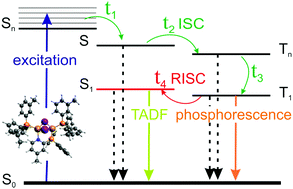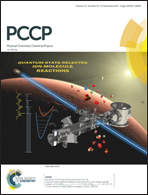Photophysical dynamics of a binuclear Cu(i)-emitter on the fs to μs timescale, in solid phase and in solution†
Abstract
Understanding subtle aspects of photophysical behavior is the key to design and synthesize new and improved luminescent materials. We contribute to this with an in-depth photophysical characterization of the binuclear copper complex Cu(I)–NHetPHOS-tris-m-tolylphosphine (1), a member of a recently established emitter class for ultra-efficient, printed organic light-emitting diodes (OLEDs). To this end we studied 1 in solution and in solid form, i.e. neat film and KBr-pellet, by means of femtosecond time-resolved transient absorption/reflectivity, time-correlated single photon counting (TCSPC), and nanosecond time-resolved step-scan FTIR spectroscopy. Using these methods, we explore the photoinduced dynamics from ultrafast Franck–Condon state deactivation until the decay of the luminescent states. Upon photoexcitation, we observed multiexponential dynamics in both solution (e.g. acetonitrile 0.8 ps, 59 ps, 3 ns, 11–13 ns) and in solid state (e.g. neat film 0.3 ps, 35 ps, 670 ps, 0.5–1 μs, 3.5–4.5 μs) with four to five time-constants that significantly depend on the type of sample. Quantum chemical calculations at the DFT level in combination with step-scan vibrational spectroscopy provided structural information about the electronic ground state S0 and the lowest lying excited state T1, and show that the latter is populated within 1 μs after photoexcitation. We found thermally activated delayed fluorescence (TADF) for this complex, which has been suggested to be the cause for its high efficiency in printed OLED devices. The results suggest that non-radiative processes, lowering the luminescence quantum yield in solution, are active on the ns to μs timescale.



 Please wait while we load your content...
Please wait while we load your content...